View in other NatureServe Network Field Guides
NatureServe
Montana
Utah
Wyoming
Idaho
Wisconsin
British Columbia
South Carolina
Yukon
California
New York
Many-flowered Viguiera - Viguiera multiflora
Other Names:
Heliomeris multiflora
State Rank Reason (see State Rank above)
Known from one extant occurrence in Beaverhead County and four historical collections from Beaverhead, Gallatin and Madison Counties.
- Details on Status Ranking and Review
Population Size
Score2-3 - Very Small to Small: Population size is imprecisely known but is believed to be <10,000 individuals.
CommentPopulation levels are imprecisely known and most location records for Montana are from several decades ago.
Range Extent
Score2 - Regional or State Endemic or Small Montana Range: Generally restricted to an area <100,000 sq. miles (equivalent to 2/3 the size of Montana or less) or Montana contributes 50% or more of the species’ range or populations OR limited to 2-3 Sub-basins in Montana.
CommentDocumented from two subwatersheds in Montana.
Area of Occupancy
Score2-3 - Very Low to Low. Occurs in 10 or fewer Subwatersheds (6th Code HUC’s), though the species' distribution is not sufficiently documented to place it within one class.
Environmental Specificity
Score1 - Moderate: Species is restricted to a specific habitat that is more widely distributed or to several restricted habitats and is typically dependent upon relatively unaltered, good-quality habitat (C Values of 5-7).
CommentPrimarily restricted to aspen stands in Montana.
Trends
Score1-2 - Minor to Moderate Declines:
CommentTrends are unknown. However, aspen stands, the species' primary habitat have declined in Montana and this species may have undergone population declines as a result. Additionally, the species is primarily known in Montana from historical collections suggesting declines may have occurred over the last several decades.
Threats
Score1 - Medium: 11-30% of the populations are being negatively impacted or are likely to be impacted by one or more activities or agents, which are expected to result in decreased populations and/or habitat quality and/or quantity.
CommentSuccessional dynamics, fire suppression and general decline in aspen are all potential threats, though the significance of the threats are uncertain.
Intrinsic Vulnerability
Score0 - Low Vulnerability: Species does not have any unusual or specific life history or biological attributes or limted reproductive potential which makes it susceptible to extirpation from stochastic events or other adverse impacts to its habitat and thus slow to recover.
Raw Conservation Status Score
Score
9 to 12 total points scored out of a possible 19.
General Description
Many-flowered Viguiera is a perennial from a short taproot or fibrous rootstock with several stems standing 20-130 cm tall. All but the uppermost leaves are opposite on the stem. Leaves are 3-10 cm long and 8-30 mm wide, short-stalked or stalkless, narrowly oval in shape, and with pointed tips and surfaces with short, stiff hairs. Flower heads are borne at the ends of the branches. The involucre is 5-10 mm high, and composed of 2-3 series of narrow green bracts. Each head has 8-16 showy yellow rays that are 1-2 cm long by 3-5 mm wide, surrounding a disk, 6-15 mm across, composed of yellow tubular flowers. The black, hairless achenes are thick and angular in cross-section, lack bristles and scales at their tops, and are clasped by chaffy bracts as in a sunflower head.
Our plants are variety multiflora.
Phenology
Flowering in late July - August.
Diagnostic Characteristics
Viguiera multiflora belongs to the sunflower Tribe Heliantheae, which are distinguished from other composites by having opposite leaves and heads with chaffy bracts surrounding the achenes. It is distinguished within this group by the 4-sided achene and lack of a pappus. A hand lens and technical key are needed for positive identification.
Species Range
Montana Range
Range Descriptions
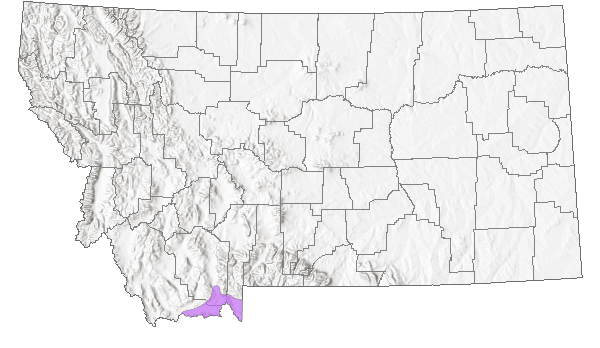
 Native
Native
Range Comments
MT to CA, AZ, NM and TX (Lesica et al. 2012. Manual of Montana Vascular Plants. BRIT Press. Fort Worth, TX). The species is used ornamentally and is being planted in areas outside of its native range and it may spread further from these plantings. As such, observations are expected outside of its suspected native range in Montana.
Observations in Montana Natural Heritage Program Database
Number of Observations: 22
(Click on the following maps and charts to see full sized version)
Map Help and Descriptions
Relative Density
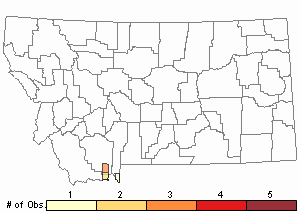
Recency

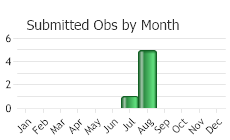
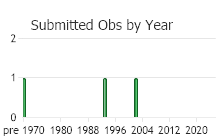
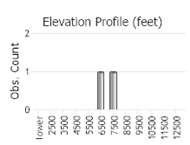 (Observations spanning multiple months or years are excluded from time charts)
(Observations spanning multiple months or years are excluded from time charts)
Habitat
Aspen woodlands and open slopes.
National Vegetation Classification System Groups Associated with this Species
Forest and Woodland
Deciduous Forest and Woodland
Montane - Subalpine Forest and Woodland
Grassland
Montane - Subalpine Grassland
Wetland and Riparian
Riparian and Wetland Forest
Ecology
POLLINATORS The following animal species have been reported as pollinators of this plant species or its genus where their geographic ranges overlap:
Bombus bifarius,
Bombus flavifrons,
Bombus rufocinctus,
Bombus insularis, and
Bombus flavidus (Pyke et al. 2012, Williams et al. 2014).
Stewardship Responsibility
Threats or Limiting Factors
STATE THREAT SCORE REASON
Threat impact not assigned because threats are not known (MTNHP Threat Assessment 2021).
References
- Literature Cited AboveLegend:
 View Online Publication
View Online Publication Lesica, P., M.T. Lavin, and P.F. Stickney. 2012. Manual of Montana Vascular Plants. Fort Worth, TX: BRIT Press. viii + 771 p.
Lesica, P., M.T. Lavin, and P.F. Stickney. 2012. Manual of Montana Vascular Plants. Fort Worth, TX: BRIT Press. viii + 771 p. MTNHP Threat Assessment. 2021. State Threat Score Assignment and Assessment of Reported Threats from 2006 to 2021 for State-listed Vascular Plants. Botany Program, Montana Natural Heritage Program, Helena, Montana.
MTNHP Threat Assessment. 2021. State Threat Score Assignment and Assessment of Reported Threats from 2006 to 2021 for State-listed Vascular Plants. Botany Program, Montana Natural Heritage Program, Helena, Montana. Pyke, G.H., D.W. Inouye, and J.D. Thomson. 2012. Local geographic distributions of bumble bees near Crested Butte, Colorado: competition and community structure revisited. Environmental Entomology 41(6): 1332-1349.
Pyke, G.H., D.W. Inouye, and J.D. Thomson. 2012. Local geographic distributions of bumble bees near Crested Butte, Colorado: competition and community structure revisited. Environmental Entomology 41(6): 1332-1349. Williams, P., R. Thorp, L. Richardson, and S. Colla. 2014. Bumble Bees of North America. Princeton, NJ: Princeton University Press. 208 p.
Williams, P., R. Thorp, L. Richardson, and S. Colla. 2014. Bumble Bees of North America. Princeton, NJ: Princeton University Press. 208 p.
- Additional ReferencesLegend:
 View Online Publication
View Online Publication
Do you know of a citation we're missing? Culver, D.R. 1994. Floristic analysis of the Centennial Region, Montana. M.Sc. Thesis. Montana State University, Bozeman. 199 pp.
Culver, D.R. 1994. Floristic analysis of the Centennial Region, Montana. M.Sc. Thesis. Montana State University, Bozeman. 199 pp. Lesica, P., M.T. Lavin, and P.F. Stickney. 2022. Manual of Montana Vascular Plants, Second Edition. Fort Worth, TX: BRIT Press. viii + 779 p.
Lesica, P., M.T. Lavin, and P.F. Stickney. 2022. Manual of Montana Vascular Plants, Second Edition. Fort Worth, TX: BRIT Press. viii + 779 p.
- Web Search Engines for Articles on "Many-flowered Viguiera"





